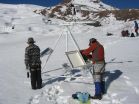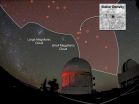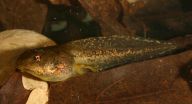(Press-News.org) Lueneburg. Sustainability Scientists at Leuphana University of Lueneburg have devised a simple screening-based predicting procedure for region-specific environmental risks caused by veterinary antibiotics (VA). This procedure, called Usage Pattern-based Exposure Screening (UPES), makes use of utilization patterns of antibiotics in animal husbandry. By improving targeting, it enables the identification of particularly problematic antibiotic substances. It also enables the implementation of more advanced risk prediction tests, for example with the help of soil and water analyses. Lüneburg researchers Prof. Dr. Klaus Kuemmerer, Jakob Menz and Dr. Mandy Schneider recently published this procedure together with a related case study on potential environmental contamination by veterinary antibiotics in north-west Germany in the Chemosphere journal.
UPES aggregates data from existing studies on the quantity and frequency of various antibiotics administered to the species treated. On this basis, the scientists modeled consumption patterns, which provide information about the concentration of antibiotics found in slurry. Starting from the manure applied as fertilizer on fields, it is then possible to draw conclusions about the expected environmental impact of individual antibiotic substances in a given region. Substances, which pose a particularly high risk to the environment because of their relatively large and frequent consumption, can be filtered out and specifically investigated in follow-up studies. Thus, potential risks for humans and the environment can be identified before they occur and evaluated more closely.
In their case study of north-west Germany, the researchers drew on two studies carried out in 2007 and 2011 by the Lower Saxony State Office for Consumer Protection and Food Safety (LAVES) and the Federal Institute for Risk Assessment (BfR) on the use of antibiotics in livestock production. "The results give rise to concern", explains Jakob Menz, the study's lead author. "Even assuming an average use frequency, environmental impacts cannot be ruled out". According to their modelization, a total of 14 antibiotic substances can occur in potentially environmentally hazardous concentrations in the region surveyed.
The Federal Environment Agency estimates that two to three times as many antibiotics are administered in veterinary medicine as in human medicine. However, the lavish use of veterinary antibiotics bears substantial risks for humanity and the environment. Livestock excrete a sizable part of these active substances untreated. Through the application of liquid manure or livestock grazing, these medical substances enter the soil, surface- and ground-waters. This could lead to aiding the spread of antibiotic resistance, for example in the form of multidrug-resistant pathogens (MRE). It could also deteriorate naturally occurring microbial communities. In highly polluted soils, the latter could, in turn, contribute to a reduction in soil fertility.
For a long time, the availability of data on the actual amounts of antibiotics administered to livestock was restricted. It is only since 2014 that meat farming businesses must make regular reports to competent authorities about the nature and quantity of antibiotics they administer. By improving the data base, the UPES procedure can, in the future, help implement detailed risk assessments and carry them out for other German regions. Moreover, UPES can easily be combined with models reaching further, which would also significantly simplify the prediction of antibiotics input in water. The Leuphana scientists are already implementing this advanced application in a joint project with the Ministry for Climate Protection, Environment, Agriculture, Conservation and Consumer Protection of North Rhine-Westphalia. The project aims at sustainably reducing the contamination charge of surface waters with veterinary medicines in the catchment area of the Haltern Reservoir.
INFORMATION:
Menz, Jakob; Schneider, Mandy; Kuemmerer, Klaus (2015). Usage Pattern-Based Exposure Screening as a Simple Tool for the Regional Priority-Setting in Environmental Risk Assessment of Veterinary Antibiotics: A Case Study of North-Western Germany. Chemosphere 127, 42-48.
DURHAM, N.C. -- We've all seen dewdrops form on spider webs. But what if they flung themselves off of the strands instead?
Researchers at Duke University and the University of British Columbia have now observed this peculiar phenomenon, which could benefit many industrial applications. As long as the strands are moderately hydrophobic and relatively thin, small droplets combining into one are apt to dance themselves right off of the tightrope. The discovery could form the basis of new coalescer technologies for water purification, oil refining and more.
The findings ...
Seasonal water shortages already occur in the Central Andes of Peru and Bolivia. By the end of the century, precipitation could fall by up to 30% according to an international team of researchers led by the University of Zurich. In a first for this region, the team compared current climate data with future climate scenarios and data extending back to pre-Inca times.
The population in the Central Andes already faces water shortages today. Now geographers at the University of Zurich have collaborated with Swiss and South American researchers to show that precipitation in ...
Over a 10 year period, the time that babies receive genetic testing after being diagnosed with diabetes has fallen from over four years to under two months. Pinpointing the exact genetic causes of sometimes rare forms of diabetes is revolutionising healthcare for these patients.
Babies with diabetes are now being immediately genetically tested for all possible 22 genetic causes while previously they would only get genetic testing years after diabetes was diagnosed and then the genes would be tested one at a time. Crucially, this means that the genetic diagnosis is made ...
Scientists on the Dark Energy Survey, using one of the world's most powerful digital cameras, have discovered eight more faint celestial objects hovering near our Milky Way galaxy. Signs indicate that they, like the objects found by the same team earlier this year, are likely dwarf satellite galaxies, the smallest and closest known form of galaxies.
Satellite galaxies are small celestial objects that orbit larger galaxies, such as our own Milky Way. Dwarf galaxies can be found with fewer than 1,000 stars, in contrast to the Milky Way, an average-size galaxy containing ...
We may view our memory as being essential to who we are, but new findings suggest that others consider our moral traits to be the core component of our identity. Data collected from family members of patients suffering from neurodegenerative disease showed that it was changes in moral behavior, not memory loss, that caused loved ones to say that the patient wasn't "the same person" anymore.
The findings are published in Psychological Science, a journal of the Association for Psychological Science.
"Contrary to what you might think -- and what generations of philosophers ...
WASHINGTON, August 17, 2015 -- Almost all of us have used some type of odor eliminator like Febreze to un-stink a room. These sprays can work wonders, but how do they actually work? Do they really remove the smell or just mask it? We explain the chemistry of odor elimination in this week's Reactions video. Check it out here: https://youtu.be/sNIIxzR-d_Q.
Subscribe to the series at http://bit.ly/ACSReactions, and follow us on Twitter @ACSreactions to be the first to see our latest videos.
INFORMATION:
The American Chemical Society is a nonprofit organization chartered ...
This news release is available in German.
Their results have now been published in the Nature journal Scientific Reports (doi:10.1038/srep13008) and could point the way toward improvements in hybrid solar cells.
The system they investigated is based on conventional n-type silicon wafers coated with the highly conductive polymer mixture PEDOT:PSS and displays a power conversion efficiency of about 14 %. This combination of materials is currently extensively investigated by many teams in the research community.
"We systematically surveyed the characteristic curves, ...
Millions of tons of road salt are applied to streets and highways across the United States each winter to melt ice and snow and make travel safer, but the effects of salt on wildlife are poorly understood.
A new study by biologists from Case Western Reserve University suggests exposure to road salt, as it runs off into ponds and wetlands where it can concentrate--especially during March and early April, when frogs are breeding--may increase the size of wood frogs, but also shorten their lives.
Wood frog tadpoles exposed to road salt grew larger and turned into ...
In addition to melting icecaps and imperiled wildlife, a significant concern among scientists is that higher Arctic temperatures brought about by climate change could result in the release of massive amounts of carbon locked in the region's frozen soil in the form of carbon dioxide and methane. Arctic permafrost is estimated to contain about a trillion tons of carbon, which would potentially accelerate global warming. Carbon emissions in the form of methane have been of particular concern because on a 100-year scale methane is about 25-times more potent than carbon dioxide ...
Magnetism in nanoscale layers only a few tens of atoms thick is one of the foundations of the big data revolution - for example, all the information we download from the internet is stored magnetically on hard disks in server farms dotted across the World. Recent work by a team of scientists working in Singapore, The Netherlands, USA and Ireland, published on 14 August 2015 in the prestigious journal, Science, has uncovered a new twist to the story of thin-film magnetism.
The team from the National University of Singapore (NUS) - Mr Li Changjian, a graduate student from ...




